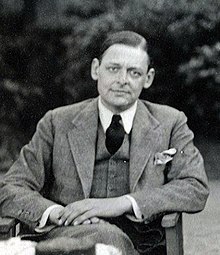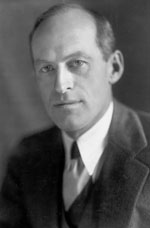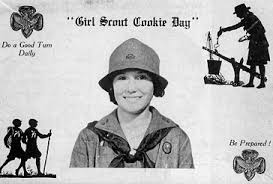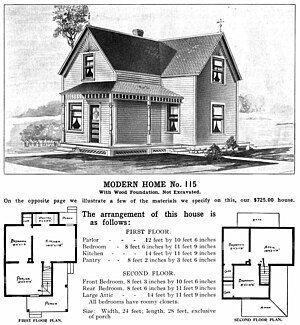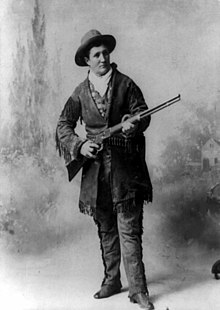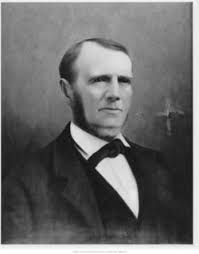 |
| John Calvin McCoy (September 28, 1811 – September 2, 1889) Considered the "father of Kansas City," Calvin was born in Vincennes, Indiana, and accompanied his parents to Kansas City in 1830 to perform Baptist missionary work. In 1833, John McCoy built a two-story cabin at what is today 444 Westport Road on the northeast corner of Pennsylvania. McCoy opened a store for travelers on the Santa Fe Trail and Oregon Trail. He named the area Westport because it was the last location before travelers ventured into the Territory of Kansas. McCoy's store was three miles from the Missouri River. He established a dock at a rocky point in the river between Main and Grand Street that came to be called Westport Landing. He followed a trail that was to become Broadway to reach it. The dock proved to be quite popular but the land surrounding it belonged to a farmer. In 1850 he and other residents banded together to buy the farm. Their company was called the Town of Kansas because the port area was the last inhabitable area before the flood-prone confluence of the Kansas River and Missouri River. A statue of McCoy stands today in Pioneer Park at Westport and Broadway. Also depicted in the statue are Alexander Majors and Jim Bridger. John Calvin McCoy is buried in Kansas City's Union Cemetery. |
The daily diary entries from Ruth Catherine McKenzie McCoy. Her daughter, author Fran Baker, has included photos, historic notes and "old-time" recipes following the entries. Readers are welcome to comment.
Saturday, March 31, 2012
Saturday, March 31, 1934
Went up to the Dime Store with Gweyn, Al and the kids. Alfreda set our hair. Ruth Ray came down in the p.m.
Friday, March 30, 2012
Friday, March 30, 1934
Didn't have to go to school today as it was Good Friday. Cleaned house. I went over to Gweyn's in the p.m.
Thursday, March 29, 2012
Thursday, March 29, 1934
Walked to school with Pauline. Ruth Ray and Gweyn and I went skating, but Pauline had to go in.
Wednesday, March 28, 2012
Wednesday, March 28, 1934
Went to school with Pauline. I stayed tonight in History and read the chapter that I missed yesterday.
 |
| Leo Hall, convicted and later hanged for Erland's Point murders On March 28, 1934, six people are massacred in a beach house on Erland’s Point, six miles northwest of Bremerton, in Kitsap County. Three days later, neighbors are alerted to the murder scene by barking dogs. Fueled by excessive and sensational press coverage, the murder investigation turns into a circus. After a week, the investigation stalls and the killer’s trail grows cold. In October 1935, 18 months after the sensational crime, Leo Roderick Bernard Hall, age 33, an ex-fighter and dry-dock worker is arrested for the mass murder. In another news-frenzied event, Leo Hall is hanged at the state penitentiary in Walla Walla on September 11, 1936. His accuser was Peggy Peterson Paulos, age 27, a local barmaid and waitress, who told police she was Hall’s reluctant accomplice in a bungled robbery at Erland’s Point. When the killing began, Paulos ran for her life. Both Hall and Paulos were charged with the murders in Kitsap County and went to trial in December 1935. The jury convicted Hall of first-degree murder, sentencing him to death; Paulos was acquitted and set free. |
Tuesday, March 27, 2012
Tuesday, March 27, 1934
Stayed home from school today. Got me a new pair shoes, hose, hat, dress. Mother got her a permanent wave. Pauline was down.
 |
| 1930s Permanent Wave Machine Patented by German inventor Charles Nessler Prior to the twentieth century, a woman with straight hair who desired curls had to spend hours heating curling irons over a flame or sleep with rags and pins in her hair in order to achieve waves. If she could not attain the desired result this way (or tired of the short-lived effects) she may have used false hair pieces instead. But beginning in the 1920s, women born with flat locks saw new hope for attaining long-lasting curls. Through the promise of science, rather daunting contraptions like this late 1930s permanent wave machine offered "permanent" results via a combination of chemicals and electrically heated clamps. To perm: Hair was wound up on spiral rods, then the machine was attached to the ends of the rods and the hair was "steamed." Finally a blower was used to cool off the hair but the scalp was often burned, sometimes even scalded. Permanent waves cost $1 in 1934. |
Monday, March 26, 2012
Monday, March 26, 1934
Went to school today with Pauline. Had History test today. Sure was hard. I rode the street car this p.m.
 |
| Founder's Zippo Lighter This unique Zippo Lighter features the signature & image of George G. Blaisdell, the founder of Zippo Lighters Blaisdell founded Zippo Manufacturing Company in 1932, and produced the first Zippo lighter in early 1933, being inspired by an Austrian cigarette lighter of similar design. It got its name because Blaisdell liked the sound of the word "zipper" and "zippo" sounded more modern. On March 3, 1936, patent was granted for the Zippo lighter. The original Zippos were made of brass but as this commodity was unobtainable due to World War II, Zippo used steel. The soldiers liked them because they were "windproof" due to the design of the windscreen and adequate rate of fuel delivery. After World War II, the Zippo lighter became increasingly used in advertising by companies large and small through the 1960s. The basic mechanism of the Zippo lighter has remained unchanged. A museum called Zippo/Case Vsitors Center is located in Bradford, Pennsylvania at 1932 Zippo Drive. This 15,000 square foot building contains rare and custom made Zippo lighters, and also sells the entire Zippo line. The museum also contains an enormous collection of Case knives. Since the Zippo company's 60th anniversary in 1992, annual editions have been produced for worldwide Zippo collectors. |
Sunday, March 25, 2012
Sunday, March 25, 1934
Mother and I went to Sunday school and church. Gweyn and Pauline and I went up to the church on 27th Street this evening.
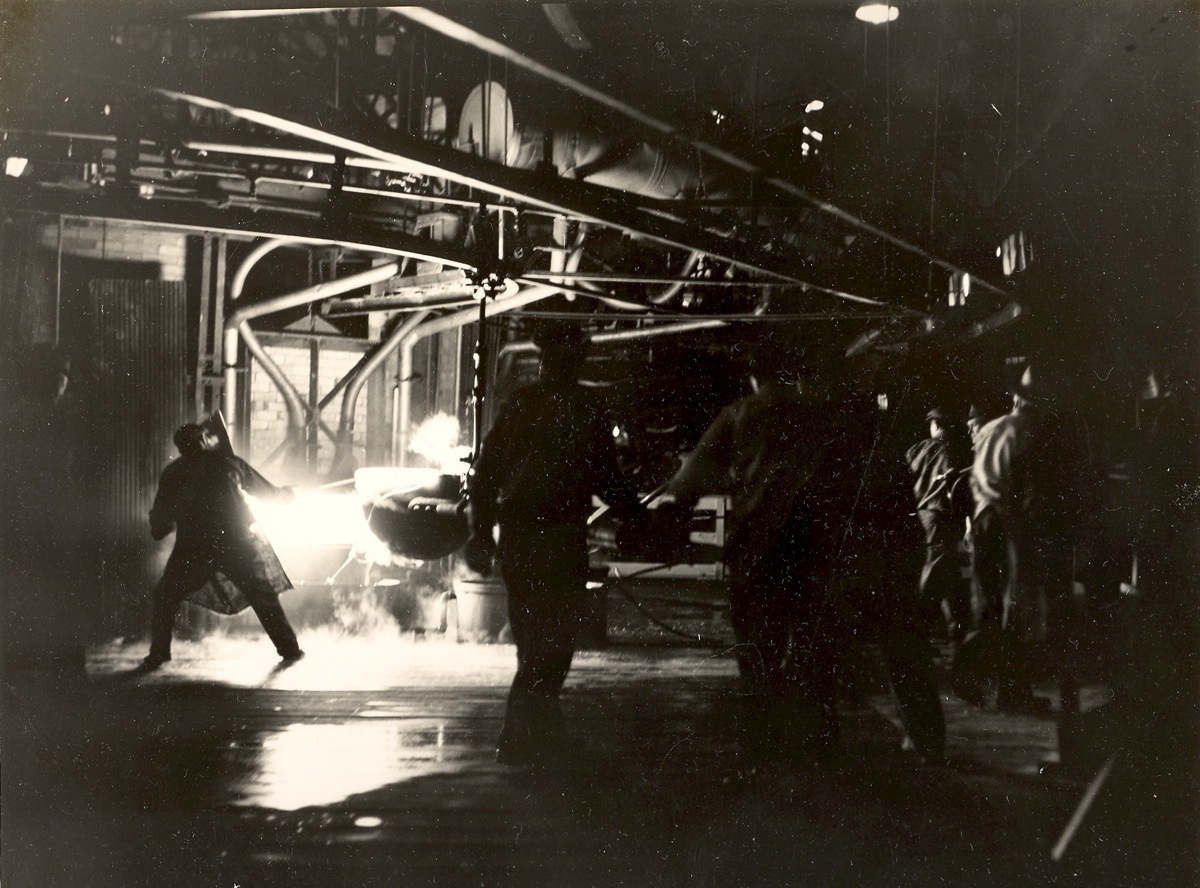 March 25, 1934 March 25, 1934 |
| This dramatic photo expertly captured the drama as on March 25, 1934 men working with molten Pyrex glass were pouring what was then the biggest mirror ever made. This casting was unsuccessful, but a second attempt to pour the 200-inch Pyrex disc was successfully completed on December 2, 1934. |
Saturday, March 24, 2012
Saturday, March 24,1934
I went over to Gweyn's. Mother and Ruth Ray and Nadine and I went to the Food Show. Aunt Kate and Helen and Laten were there.
Friday, March 23, 2012
Friday, March 23, 1934
Walked to school with Pauline. Walked home with Pauline, Nadine and Ruth Ray.
 |
| March 23, 1934 - Wichita, Kansas canning kitchen Both male and female workers at a 1934 Wichita canning kitchen can meat that will eventually be distributed to relief clients suffering during the Great Depression and Dust Bowl of the 1930s. This program was supervised by the Kansas Emergency Relief Committee. Courtesy of the Kansas State Historical Society |
Thursday, March 22, 2012
Thursday, March 22, 1934
Daddy took me to school. In the evening Gweyn and I went up to Irving to see the Open House program the kids gave.
 |
| Horton Smith - AKA "The Missouri Rover" Won the first Masters golf championship with a score of 4-under 282 March 22, 1934: The first Masters golf championship began in Augusta, Georgia. Georgia’s most famous golf championship was won three days later by Horton Smith. He edged Craig Wood by one stroke, finishing at 4-under 282. The Masters was so new in 1934 that it wasn't even called The Masters. Co-founder Clifford Roberts wanted from the start to use that name for the event, but co-founder Bobby Jones thought the name too presumptuous. So in 1934 the tournament was born as the "Augusta National Invitation Tournament." In 1939 it was officially named The Masters. |
Wednesday, March 21, 2012
Wednesday, March 21, 1934
Tonight Daddy took Mother, Ruth Ray, Nadine, Pauline and I to the Food Show. Had a swell time. Got a lot of samples.
 |
| Kansas City Kitty and Georgia Tom Recording Date: May 13, 1930 - Nov 1, 1934 Genre: Blues Style: Country/Pre-War/Regional/St. Louis Blues Kansas City Kitty was a name used by a woman or women who made records with Georgia Tom Dorsey during the early '30s. About 60 years later, Document released a collection of 16 Vocalions recorded in March 1931 and four sides cut for Bluebird in November 1934, on which someone operated a kazoo so skillfully that it sounded at times like a cornet. |
Tuesday, March 20, 2012
Tuesday, March 20, 1934
Walked home with Nadine, Pauline, Beatrice and Virginia. Saw Bernice. Sure was cold today, especially coming home.
Monday, March 19, 2012
Monday, March 19, 1934
Had ballroom dancing in Gym. Miss Pape played the piano. Walked home with kids.
Sunday, March 18, 2012
Sunday, March 18, 1934
Mother and I went to Sunday school and church. In the evening Gweyn and I took a walk. Then went to church at 27th. Mother was there.
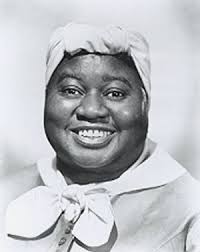 |
| Hattie McDaniel (June 10, 1895 – October 26, 1952) Born in Wichita, Kansas to former slaves, Hattie McDaniel was the youngest of 13 children. She graduated from Denver East High School after her family moved to Colorado and went to work with her brother's minstrel show. In addition to performing, Hattie was also a songwriter and singer who appeared with Professor George Morrison's Melody Hounds, a touring black ensemble. She also sang on radio. In 1931, Hattie moved to Los Angeles, where she appeared in hundreds of films as an extra, playing maids and mammies, roles she had lampooned on the vaudeville stage. In 1934, McDaniel joined the Screen Actors Guild (SAG) and began appearing in major motion pictures. With competition stiff for the part of Mammy in "Gone With the Wind," McDaniel auditioned in an authentic maid's costume and won the role. For the role of Mammy, Hattie McDaniel received an Academy Award for best supporting actress, the first African-American to win an Oscar. |
Saturday, March 17, 2012
Saturday, March 17, 1934
I was going to the Weiner Roast at church but as it was cold and snowed more, didn't go. Walked to Dime Store with Ruth Ray, then went to her house.
 |
| Rome Protocols - March 17, 1934 The Rome Protocols were a series of three international agreements signed in Rome on March 17, 1934 between the governments of Austria, Hungary and Italy. They were signed by Italian Prime Minister Benito Mussolini, Austrian Prime Minister Engelbert Dollfuss and Hungarian Prime Minister Gyula Gombos. All three protocols went into effect on July 12, 1934, and were registered in League of Nations Treaty Series on December 12, 1934. The protocols, even though only dealing with economic development, were part of the process of cooperation between the three signatory governments against the revisionist policies of Hitler, who had just come to power in Germany, as well as against the territorial integrity of Yugoslavia, which they wished to dismember among themselves. Cooperation under these protocols was short-lived, as Mussolini joined hands with Hitler against Austria, and the Hungarian government under Miklos Horthy also joined the Third Reich in 1938. |
Friday, March 16, 2012
Friday, March 16, 1934
Stayed home today. Cold and snow.
Thursday, March 15, 2012
Thursday, March 15, 1934
I waited for Pauline and Nadine. Then Pauline's father came after us kids. Bernice was with us.
 |
| "The Green Box" Written by Walter B. Gibson writing as Maxwell Grant Published March 15, 1934 Sanctum Books #59 What is the strange secret of "The Green Box" that is worth human life? The Shadow seeks the deadly secret in a masterpiece of misdirection that introduced aides Hawkeye and Tapper. Who knows what evil lurks in the heart of men? The Shadow knows! |
Wednesday, March 14, 2012
Wednesday, March 14, 1934
Walked to school with Pauline. Then we met Ruth Ray and us kids walked with her to school.
Tuesday, March 13, 2012
Tuesday, March 13, 1934
I walked to school by myself. Ruth Ray went to Girl Scouts so I walked home by myself.
Monday, March 12, 2012
Monday, March 12, 1934
Daddy took Virginia, Beatrice and me to school. Nadine came to the library, but Pauline didn't.
 |
March 12, 1934 - Lieutenants E.C. Plummer (left) and H.M. McCoy preparing for an airmail flight at Newark, New Jersey, airfield. The first regularly scheduled airmail service began in the U.S. on May 15, 1918. The Post Office Department (POD) oversaw the service, but having no reservoir of experienced pilots, looked to U.S. Army Air Corps pilots to fly the mail for the first three months. On August 12, 1918, the POD took over full control of the service, using its own pilots. The Department transferred responsibility for airmail service over to private companies in the late 1920s through a series of acts aimed at using postal funds to support the nation’s fledgling aviation industry. Young aviation companies snatched up most of the postal pilots, who were greatly prized for their mail flying experience. |
Sunday, March 11, 2012
Sunday, March 11, 1934
Mother went to church, but I stayed home and got dinner. In p.m. went to Linwood with Ruth Ray and Nadine and saw "Little Women."
Saturday, March 10, 2012
Saturday, March 10,1934
Skated up to the Dime Store with Nadine, Ruth Ray and Bobby. Got rose fingernail polish. Went with Gweyn to Sears Roebuck's.
Friday, March 9, 2012
Friday, March 9, 1934
Today was Mother's birthday. Walked to school with Pauline. She got mad after school. Ruth Ray and I walked over to Central Junior's program.
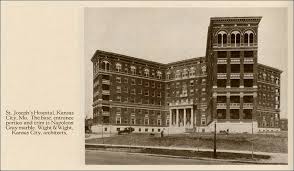 |
| St. Joseph Hospital - 1917-1977 Linwood & Prospect Kansas City, Missouri Founded in 1874 by the Sisters of St. Joseph of Carondelet, St. Joseph Hospital was originally housed in the old Waterman house at 7th and Pennsylvania. In 1917 the new hospital opened at Linwood and Prospect. It was the latest word in hospital construction as it was built in the shape of an "X" so that every room was on the outside. The hospital moved to its present location at I-435 and State Line in 1977. |
Thursday, March 8, 2012
Thursday, March 8, 1934
Walked to school with Pauline. In the evening I got Mother a kettle. Us 4 (Ruth Ray, Pauline, Mother and I) went to show. Saw "Beer & Pretzels" and two other comedies and "The Solitaire Man." Got a green bowl at show.
 |
| "Beer & Pretzels" - 1933 Starring Ted Healy & His Stooges Plot summary: MGM Stooges two reeler is a great example of the act when it was Ted Healy & His Stooges. When the foursome is thrown out of the theater, the Stooges demand Healy swears off off "da goils." So, its up to the Stooges to keep Healy away from the female of the species. Desperate for work, the group gets hired as waiter/entertainers in a beer hall. The short seems to set the template for the Columbia shorts that followed as the inept Stooges slap each other silly in between making their boss regret he ever hired the trio (not to mention Healy). As is the formula in the MGM shorts, there are great musical numbers in between the Stooges schtick. This includes a wild dance routine by Bonnie Bonnell and the Three Ambassadors doing "Steins on the Table" celebrating the end of prohibition and joined in by a cigar smoking Curly who plays a mean set of spoons! Incredibly elaborate all out night club fight finale shows MGM spent money on these shorts. |
Wednesday, March 7, 2012
Wednesday, March 7, 1934
Walked to school with Pauline. Sure cold. Daddy lost his job so he came after us kids. Ruth Ray and Nadine were down.
Tuesday, March 6, 2012
Tuesday, March 6, 1934
Walked to school today with Pauline. Mrs. Raifert came over. Played pinochle. Nadine was down. We drawed pictures.
Monday, March 5, 2012
Monday, March 5, 1934
Walked to school by myself. In the evening Ruth Ray and Pauline came down. Played the Victrola. Danced.
Sunday, March 4, 2012
Sunday, March 4, 1934
Went to church and Sunday school. Went over to Montgall Park and played tennis with Sunday school class. In the evening we went to 27th Street church with Pauline, Nadine and Ruth Ray. Readings.
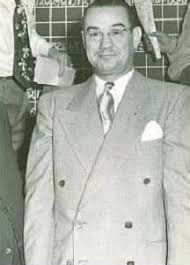 |
| Charles Binaggio (January 12, 1909 - April 5, 1950) Another of the Five Iron Men of Kansas City, Binaggio rose through the ranks of the Mob to become the boss of the Kansas City crime family. He earned his prominence in the "family" by making a lot of money from liquor and gambling. On July 20, 1931 Binaggio was arrested in Kansas City following a shootout that killed a Bureau of Prohibition agent and two others. After questioning him, the police determined that he hadn't taken part in the shootout and released him with a vagrancy charge. Following his release, Binaggio was taken under the wing of John Lazia, who had established a political club (the North Side Democratic Club) in order to increase his mob's power. This led to Binaggio's involvement with the local and State political scene that would last until his death in 1950. After Lazia was assassinated in 1934, his underboss Charles V. "Charley the Wop" Carollo ascended to the crime throne. At some point it is believed that Binaggio became Carollo's underboss. In 1939, Carollo was caught up in a citywide clean-up campaign and he was sent to prison for income tax evasion. This led to the rise of Binaggio to the position of the city's mob boss in October of 1939. On the night of April 6, 1950, Binaggio and his underboss, Charles "Mad Dog" Gargotta (a notorious enforcer within the Kansas City family), were called to meet some unknown persons at the First Ward Democratic Club near downtown Kansas City. Binaggio left his driver/bodyguard, Nick Penna, at a tavern owned by the mob, saying that he would return in a few minutes. Binaggio and Gargotta then borrowed a car and drove off to the Democratic Club. Shortly after 8 P.M., residents in apartments above the Democratic Club heard several shots. Eight hours later, a cab driver going to a nearby cafe noticed that the club door was open; he also heard water running inside. The police were called and they found the bodies of Charles Binaggio and Charles Gargotta inside the club. Binaggio was seated at a desk and Gargotta was lying inside the front door. Both men had been shot in the head four times with separate .32 caliber revolvers. |
Saturday, March 3, 2012
Saturday, March 3, 1934
Gweyn and the kids, Mother and Nadine and I walked up to the Dime Store on 31st. Went to show with Nadine. Saw "Day of Reckoning" and "Diamond Trail."
 |
| Day of Recknoning starring Richard Dix and Madge Evans Co-starring: Conway Tearle, Una Merkel and George "Spanky" McFarland Directed by Charles Brabin Run time: 69 minutes Black and white Plot Summary: In this brutal prison drama a hen-pecked husband is sentenced to prison after getting caught with his hand in the company till. He is sent to a high-rise facility in LA. It seems the fellow was only following the instructions of his domineering, constantly nagging wife who, as soon as he is put away, takes up with a more successful businessman. This causes her new lover's ex-lover to get insanely jealous and kill the conniving wife. The businessman decides to take the blame for the death and he is sent to the same jail as the dead woman's husband. One of the two meets a violent end. |
Friday, March 2, 2012
Friday, March 2, 1934
Walked to school with Pauline. In the evening I walked home with Bernice, Pauline and Nadine.
 |
| John Herbert Dillinger, Jr. (June 22, 1903 – July 22, 1934) Federal Public Enemy Number One On March 2, 1934, that notorious gangster John Dillinger walked into a jail cell in Crown Point, Indiana. He was charged with the murder of a police officer in East Chicago. The jailer was confident that the jail was impossible to escape from, but Dillinger proved him wrong and escaped. Dillinger was in his jail cell when the janitor entered and Dillinger jumped him, jamming a piece of wood carved into the shape of a gun into his ribs. (Dillinger's lawyer at the time brought the wooden gun to him.) Dillinger tricked half a dozen guards back into the cell block, took their weapons and locked them up. After making his escape, Dillinger stole the sheriff's car and drove across the Indiana/Illinois state line to Chicago. When he crossed the state line with a stolen car he became a federal fugitive, under the National Motor Vehicle Theft Act called the Dyer Act. Crossing the state line in the stolen vehicle was Dillinger’s fatal mistake, because this was what made him a federal criminal. |
Thursday, March 1, 2012
Thursday, March 1, 1934
I went swimming today in Gym. Swam 2/3 length. Walked home with Bernice, Pauline and Nadine.
 |
| "Hooverville" in Seattle, Washington A 'Hooverville' was the popular name for shanty towns built by homeless people during the Great Depression. They were named after the President of the United States at the time, Herbert Hoover, because he allegedly let the nation slide into depression. The term was coined by Charles Michelson, publicity chief of the Democratic National Committee. Homelessness was present before the Great Depression, and hobos and tramps were common sights in the 1920s, but the economic downturn increased their numbers and concentrated them in urban settlements close to soup kitchens run by charities. These settlements were often formed on empty land and generally consisted of tents and small shacks. Some of the men who were forced to live in these conditions possessed construction skills and were able to build their houses out of stone. Most people, however, resorted to building their residences out of wood from crates, cardboard, scraps of metal, or whatever materials were available to them. They usually had a small stove, bedding and a couple of simple cooking implements. The New Deal enacted special relief programs aimed at the homeless under the Federal Transient Service (FTS), which operated from 1933-35. |
Subscribe to:
Posts (Atom)
